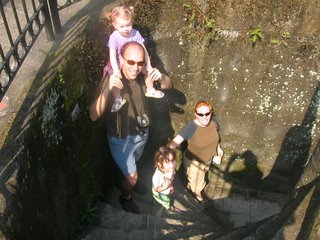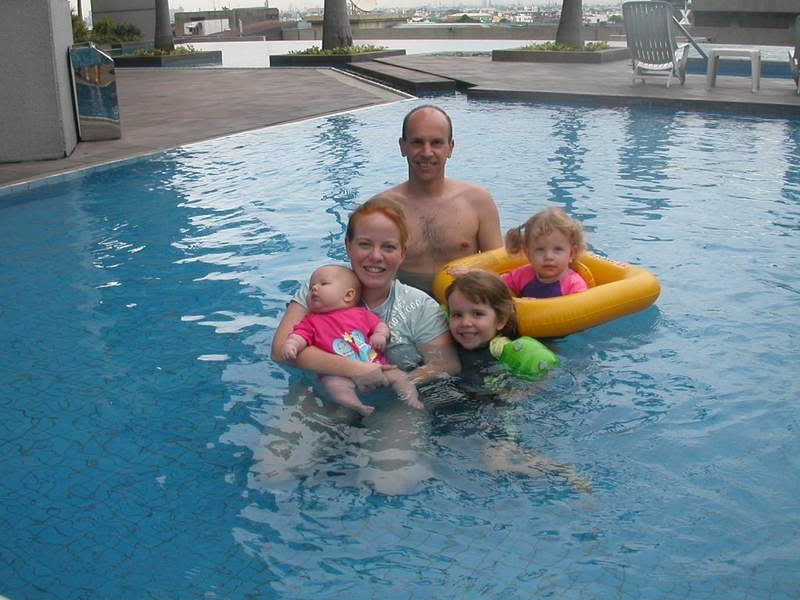Trip to Intramuros
This is most of an article I wrote for the MADS (Mothers and Darlings) magazine, (which I will actually be editing next year!) I thought there was no point in re-inventing the wheel, so here is an account of our recent trip to “Intramuros”:
We’re still fairly new to Manila, and although we are attracted to the idea of leaving the ‘big smoke’ at weekends, our budget doesn’t allow that too often, so we are constantly trying to find ways to fill our Saturday mornings with family friendly ‘discovery outings’ around town. I thought I’d share with you one trip we did recently that turned out to be quite successful.
We went to Intramuros. It’s by no means a ‘secret’ place, in fact it’s in any tourist brochure about Manila worth it’s printing cost. If you’ve been here any length of time, this is probably old news, but for those fairly new, it’s definitely worth a visit, and CAN be family friendly!
We left early on a Saturday, due to the pleasantly surprising early opening time of Fort Santiago, where the tourist information is. At about 8:30, we parked our car for free just outside, which wouldn’t have been possible much later, as several busses arrived shortly after. There was a small entrance fee.
Fort Santiago itself is beautiful, and for very young children, would have made a sufficient outing in itself. There are manicured lawns and trees for a bit of shade, and from mum’s perspective, best of all is the wee ‘café’ (label used loosely) that served coffee on the cobblestone pavements. I think was just instant, but as we hadn’t passed any Starbucks or Coffee Bean on the way that was actually open, it would have to do. (and from Dad’s perspective, it had better do – mum was desperately in need of a caffeine fix!) While seated at our table enjoying the drinks and plastic-wrapped snack food, watching the girls running around blowing bubbles, we were approached and asked whether we wanted a guided tour of Intramuros by horse-drawn carriage.
 We decided that for our children’s sake, we’d accept. As they are still quite young, they wouldn’t handle much walking, and Dad was very keen to explore the history of the place, so this killed several birds with one stone – one of which was simply giving the children a ride in vehicle they have never experienced before!
We decided that for our children’s sake, we’d accept. As they are still quite young, they wouldn’t handle much walking, and Dad was very keen to explore the history of the place, so this killed several birds with one stone – one of which was simply giving the children a ride in vehicle they have never experienced before!Our guide/host was very entertaining! He was obviously a veteran at giving tours, and his memorized knowledge was impressive. He threw in several jokes, and even threw in a few songs and voice impressions of cartoon characters – all of which unfortunately were lost on our two children, who have never seen a Popeye cartoon, and couldn’t join in with the Beatles songs, but mum and dad appreciated the light relief.
Intramuros, as you are probably aware, is what’s left of a walled city, which had its heyday in the Spanish occupation. If you have ever been on a British or European “ABC tour” (Another Bl**dy Castle/Church/Cathedral), you will know about walled cities. The thing is, it’s the only one of its kind here in the Philippines (and Asia?). It really does seem out of place, but it helps you to imagine what life would have been like under the Spanish rule, where they tried to make Manila into a far away piece of Spain.
 There are cathedrals, convents, secret tunnels, and all the other stuff that makes walled-cities what they are. Some things just didn’t work here in Asia, however. The former moat, which in Europe would have hosted crocodiles, and killed anyone who tried to cross it, ended up causing a malaria epidemic, killing those inside the city as well as outside! (Today, the moat has been transformed into a golf course, going right around the city.) For older children, touring intramurous would be made more interesting, no doubt, if you prepare them by reading fairy tales about walled cities, castles and moats and secret tunnels etc. Make history come alive for them!
There are cathedrals, convents, secret tunnels, and all the other stuff that makes walled-cities what they are. Some things just didn’t work here in Asia, however. The former moat, which in Europe would have hosted crocodiles, and killed anyone who tried to cross it, ended up causing a malaria epidemic, killing those inside the city as well as outside! (Today, the moat has been transformed into a golf course, going right around the city.) For older children, touring intramurous would be made more interesting, no doubt, if you prepare them by reading fairy tales about walled cities, castles and moats and secret tunnels etc. Make history come alive for them! 
At the end of our tour, we returned back to Fort Santiago, and saw the museum dedicated to Jose Rizal’s life, including the room that he was captive in for his last days. Rizal was a highly educated, intelligent Filipino, who dedicated his life to stirring up a revolution, and freeing the Philippines from colonial powers. He lost his life for the cause, but it was not in vain, as the Philippines became independent just a few years later. The exhibition on Rizal is actually quite touching. His famous ‘final farewell’ (“Mi Ultimo Adios”) is available translated into English, and is incredibly moving; “Farewell, my adored Land, region of the sun caressed, Pearl of the Orient Sea, our Eden lost, with gladness I give you my Life…”
While we didn’t have a heck of a lot of time to spend at this part of the tour, due to the kid’s tethers, we decided that as a couple, we’d like to come back another time to appreciate it more. It piqued our interest so much, in fact, that the other day, we bought a DVD about Rizal’s life (“Jose Rizal”) We haven’t watched it yet, so I can’t tell you whether it was any good, but it did win 70 local and international awards, so I’m feeling confident.


0 Comments:
Post a Comment
<< Home